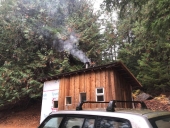So I made a tiny sample... Found an old metal "fold open" can from a pack of sawzall blades.
This stuff is rather interesting! It gets "clinker" hard.
I should have let it cook a little bit longer, as the piece that remained whole (the other broke when I dropped the can on the ground taking it out with metal tongs to set it on a rock outside.) as evidenced by some still brown portions in the center of that piece, and smoke emanating when I did a "protect the finger from a blow-torch/calibri style lighter" test. Still kept my finger from feeling anything for a good 15 seconds, even though smoke was wafting up from both the flame side and finger side of the bread.
I only kept it in until flames stopped shooting out of the seams of the can... So now I know not to be shy about "leaving it in the fire too long"
Made lovingly, with the "honey wheat" bread I had on hand, (similar in density to wonder bread, but with some whole wheat flour and no corn syrup) it is softer than perlite, in terms of crush resistance, but seems like it could be an excellent, ultra light weight, high heat insulator.
Shrinks and deforms a lot, during the pyrolysis, but seems to have rather excellent insulative qualities, for being an "open cell" type foam.
Well dang... I think I'm going to have to build a bigger pyrolyzer setup.
Besides shape changes during pyrolzation, the other major issue might be that thick buildup of it, might insulate themselves so well that the center of thick parts might never burn out during pyrolyzation, without a REALLY extended period at heat.
I took a piece and wetted it thoroughly and it shows no sign of softening.
I need to get a sealable metal container I can drill some holes in and try to make a heat riser and burn tunnel in sections. The feed area will need something harder, but I figure from there on the carbonized bread foam may well be just fine. Ash clean out will probably be best done with compressed air to minimize tool damage to burn tunnel and riser.
First full scale experiment is going to be building a small radiant heat rocket 3" for my perpetually freezing sweetheart to use on the porch instead of the electric heater she "heats the outdoors" with now.
My daughter is still giving me dirty looks about making the living room smell like badly burnt toast.
Outdoors next time.

Photo below is my "high tech" pyrolysis chamber and the one unbroken piece and pieces of the broken one.
They were cut to fill the tin width wise, originally.
I will have to see if "stuffing the tin" produces more uniform results.

 1
1




 2
2






























































 2
2













